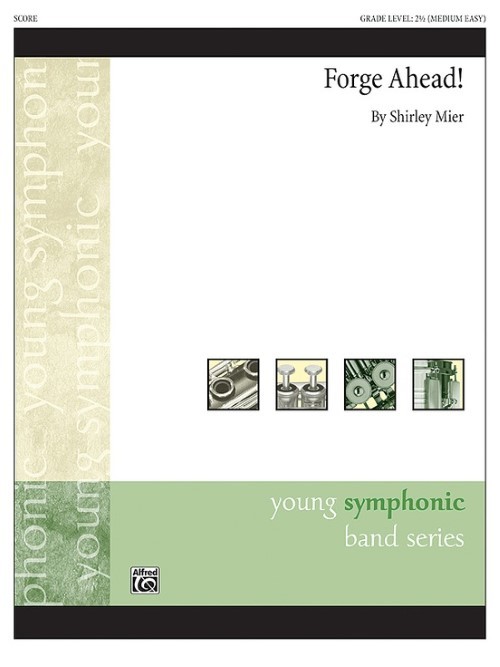Results
-
 £38.00
£38.00Fanfare Supernova
Open your beginning band's very first concert with this bold new fanfare by popular composer Larry Clark. Like a supernova, your band will explode right from the start with this forceful new piece that sounds much more difficult than it is to play. Fanfare Supernova contains biting fanfare-like harmonies, though it only contains the first six notes of the Bb scale and the most difficult rhythms in the winds are quarter notes.
Estimated dispatch 12-14 working days
-
 £58.50
£58.50Forge Ahead! (Concert Band - Score and Parts) - Mier, Shirley
Beginning with a celebratory fanfare, followed by a hushed yet animated melody in the clarinets, the music intensifies, growing in excitement and volume while exploring different themes and sounds as various instrument groups are highlighted. After a moment of reflection and remembrance, the original melody returns in a new key, with a new melody joining in counterpoint as the music drives ever faster toward its exhilarating conclusion.Duration: 4:15
Estimated dispatch 7-14 working days
-
 £84.99
£84.99Millennium Fever Wind Band Set (Score & Parts)
The new millennium inspires curiosity, optimism, and fear of the unknown. Belgian composer Johan Nij composed Millennium Fear to capture the uncertainty of this monumental event. The piece combines dynamic sounds, feverish rhythms, and surprising sound textures in the dialogues between different instrument groups. The piece expresses the thoughts and feelings many have toward the new millennium. 0:02:35
Estimated dispatch 7-14 working days
-
 £274.99
£274.99Stone Age (Concert Band - Score and Parts) - Doss, Thomas
Stone Age, Middle Age and New Age are the three distinct sections of this single movement work at the highest level. Whilst Stone Age has a menacing and ancient atmosphere, an old German song can be made out in Middle Age - vocals, guitar, recorder or even bagpipes can be incorporated into the melody, which gradually gives up merry Celtic dances. In New Age, the 'present', the Celtic sounds finally connect with untamed, rousing dance rhythms.Duration: 18:30
Estimated dispatch 7-14 working days
-
£84.99
Millennium Fever - Johan Nijs
The new millennium inspires curiosity, optimism, and fear of the unknown. Belgian composer Johan Nij composed Millennium Fear to capture the uncertainty of this monumental event. The piece combines dynamic sounds, feverish rhythms, and surprising sound textures in the dialogues between different instrument groups. The piece expresses the thoughts and feelings many have toward the new millennium.
Estimated dispatch 7-14 working days
-
 £113.30
£113.30Moderate Dances - Angelo Sormani
This piece is a tribute to dance music, especially passionate, intense and meditative dance music. "Moderate Dances" is divided into three movements: a "Tango", a "Slow Waltz" and a "Bossa Nova". Each movement and each dance has its own particular characteristics but, when combined, these different rhythmic beats and times give the piece a feeling of completeness and uniformity. The Tango started to flourish in the suburbs of Buenos Aires in around 1880. There is still some doubt as to its origins, which may be Cuban (Habanera) but are probably African. It was most popular in Argentina and Brazil: here the male protagonist was originally the "gaucho" with his inseparable guitar, later to be replaced by the proud, elegant "compadre". By around 1910 the Tango had spread to Italy and France. New clubs opened, where the upper classes could watch and dance the Tango. Here the dance also underwent some rapid transformations. The exaggerated and extravagant gestures and body movements disappeared. Slow, gliding steps replaced the old rotational movements. The women's red ankle-boots and the partners "staring into each other's eyes" accentuated the erotic nature and sensuality of this dance. So much so that, in 1913, the German government banned soldiers from dancing the Tango. Those who broke the law were immediately discharged from the army. From a strictly musical perspective, the basic instruments were a flute, a harp (the diatonic harp typically played by the Indians of Paraguay) and a violin, or flute, guitar and violin or even clarinet, guitar and violin. These instruments were easy to transport, ideal for playing at parties, in the streets and in courtyards. The musicians played by ear, frequently improvising: there were no scores, no records, which is the main reason why it is impossible to trace the Tango back to its exact origins. However, the Tango's evolution (and growing popularity) was once again fostered by its fundamental ability to absorb "other" cultures, languages and sounds. And it was the arrival of the "bandoneon" (an accordion-like instrument that was invented in Germany and brought to Rio de la Plata by some immigrant), which replaced the flute, that marked the beginning of the Tango's huge success outside Argentina. A number of talented composers, above all the great Astor Piazzola (1921-1992), transformed the bandoneon from a simple accompanying instrument to a solo instrument that was to become the distinguishing feature of the 20th century Tango. The Slow Waltz originated from the Waltz, the typical dance of the Bavarian and Tyrolese peasants in the 1700s. It was composers like Johann Strauss, father and son, who carried the Waltz to its zenith in the 1800s, creating the sensual and melancholy yet joyful and charming dance we are all familiar with. When the Waltz first became popular in Germany, the members of respectable society were shocked at the closeness of the dancing partners, who had always previously danced apart. The main difference between the Waltz and Slow Waltz is that the latter has a slower, more expressive rhythm: the men wear tails and the women wear ball gowns decorated with beads and feathers and couples dance in graceful rotational movements. "Bossa Nova" is the title of the last movement in the piece. Jobim, the great Brazilian musician, described this musical genre as a combination of modern Jazz and Samba. Bossa Nova means "new wave". This was the name of the artistic and musical movement that evolved in Brazil in the late Fifties and was extremely popular throughout the Sixties. The songs are usually about love or social matters, drawing inspiration from the slums of Rio De Janeiro and the lives of their inhabitants. Bossa Nova, with its original compositions and the artistic talent of its musicians, also became hugely popular in the United States and Europe, and top Jazz musicians (Ella Fitzgerald, Stan Getz, Bob Cooper, Charlie Bird, Sonny Rollins, Dexter Gordon, Dizzy Gillespie) started to include Bossa in their repertoires.
Estimated dispatch 7-14 working days
-
 £82.50
£82.50A Christmas Bell Carol - Randall D. Standridge
When arranging a familiar holiday favorite, the challenge is always to hear it in a completely new way. As more and more versions of these well-known classics flood the market every year, it becomes harder to see each tune in a new light. This setting takes the popular Ukrainian Bell Carol and uses it to create a gentle presentation in the style of a lyric lullaby that truly reflects the peaceful and most appealing sounds of the season.
Estimated dispatch 7-14 working days
-
£56.50
Fanfare Supernova - Larry Clark
Open your beginning band's very first concert with this bold new fanfare by popular composer Larry Clark. Like a supernova, your band will explode right from the start with this forceful new piece that sounds much more difficult than it is to play. Fanfare Supernova contains biting fanfare-like harmonies, though it only contains the first six notes of the Bb scale and the most difficult rhythms in the winds are quarter notes.
Estimated dispatch 7-14 working days
-
 £122.50
£122.50Brilliant Beatles - Peter Kleine Schaars
There have been many arrangements of Beatles' songs for various kinds of ensembles, so rather than just producing a further medley of Beatles' hits, Peter Kleine Schaars has added a new twist to them with this excellent new work. All You Need Is Love and With a Little Help from my Friends pass by in a swing march, Michelle sounds like a newly composed ballad and When I'm Sixty Four is played in Dixie swing style. A Hard Day's Night is transformed into a funk theme with a samba interlude, Let It Be into a slow march, and Ob-La-Di, Ob-La-Da in a rock beat. Experience The Beatles as you have never heard them before.
Estimated dispatch 7-14 working days
-
 £274.99
£274.99Stone Age - Thomas Doss
Stone Age, Middle Age and New Age are the three distinct sections of this single movement work at the highest level. Whilst Stone Age has a menacing and ancient atmosphere, an old German song can be made out in Middle Age vocals, guitar, recorder or even bagpipes can be incorporated into the melody, which gradually gives up merry Celtic dances. In New Age, the 'present', the Celtic sounds finally connect with untamed, rousing dance rhythms.
Estimated dispatch 7-14 working days
